Author(s): Tahsin Sultana*, Shafiul Islam Shahi, Tabassom Rehnuma Raisa, Fahmida Ali Ria, Nafisa Nawar Tamzi and Md Faisal
The study aimed to compare the nutritional and fatty acid composition of three dried fish species, Otolithoides pama, Trichiurus haumela, and Harpodon nehereus, of Bangladesh and imported sample of India and Myanmar. Proximate compositions were analyzed using the AOAC method with modifications, and fatty acid analyses were conducted via Gas Chromatography Mass Spectrometry (GCMS). Overall, the quality of fish samples from all three countries was deemed excellent. The dried Harpodon nehereus from Myanmar stood out with the highest protein content (62.81±2.83%) among the species, while also exhibiting the highest lipid content (11.03±0.39%). Indian Harpodon nehereus had the highest ash content (10.18±0.72%), and Bangladesh’s dried Harpodon nehereus had higher moisture and fiber content. For Trichiurus haumela, the Bangladeshi sample had the highest protein and lipid content, whereas Myanmar’s sample had the highest ash concentration. Moisture and fiber content were higher in Myanmar and Bangladesh. Otolithoides pama displayed variations in protein, ash, moisture, and fiber content across countries, with India having the highest moisture content. The major fatty acids identified included Methyl Palmitate, Methyl Palmitpleate, Methyl Laurate, Methyl Arachidonate, and Methyl Stearate, with notable levels of Methyl Linoleate in all three species, particularly in Bangladeshi Trichiurus haumela. In summary, the study revealed significant compositional variations in dried fish from different countries.
Drying as a food preservation technique operates by extracting moisture from the food, which hinders the proliferation of microorganisms. The preservation of fish through drying is an ancient and widespread practice, varying depending on the type of fish, geographic region, and local accessibility. This method is commonly employed in inland areas and remote coastal islands where refrigeration or freezing facilities are scarce [1]. Dry fish holds a special place in the culinary culture of our country and is often referred to as “SHUTKI”, considered a delicacy by the majority of people [2]. In our country, the process of drying is commonly applied to species such as Bombay duck, pink perch, croakers, mackerel, soles, seer fish, silver bellies, ribbon fish, and anchovies [3].
When fish are subjected to traditional air drying or exposure to sunlight, moisture migrates to the surface and subsequently evaporates when warm, dry air passes over the fish’s exterior. Any method of drying that eliminates moisture encompasses both the transfer of water from the interior of the item being dried and the evaporation of water vapor from its surface [4]. The final product ideally should have its moisture content reduced to below approximately 15-16%, a level at which most microbial and enzymatic activities are expected to be inhibited or cease [5]. The traditional sun-dried products often experience a significant decline in their physical and sensory characteristics as a result of adverse weather conditions [6].
Dried fish contains protein and other essential nutrients necessary for sustaining a healthy body [7]. Consuming 100 grams of highquality dried fish can supply the body with 52-73% of its daily protein needs, making it a convenient protein source [8]. Dried products made from small fish have minimal cholesterol content and, notably, are abundant in essential vitamins and minerals such as iron, calcium, and phosphorous [9]. These dried fish products offer an improved nutrient profile and serve as a viable protein alternative for the population in Bangladesh.
The present study seeks to thoroughly examine and compare the proximate composition, amino acid profile, and fatty acid composition of three economically important dried fish types imported from India and Myanmar, as well as samples from Bangladesh. The objective of this initiative is to ensure thedevelopment of products that are safe and of outstanding quality for consumers in our country.
The dried fish varieties employed in the research included Pama Croaker (Otolithoides pama), Bombay duck (Harpodon nehereus), and Ribbon fish (Trichiurus haumela). The dried fish sample was collected from Cox’s bazar and Ashadgonj dried fish market of Chattogram.
The research was carried out at the Faculty of Fisheries, Chattogram Veterinary and Animal Sciences University (CVASU), with the nutritional analysis conducted in the Nutrition and Processing Laboratory at CVASU. The study spanned one year, running from July 2022 to June 2023.
Sensory techniques were employed within the laboratory to evaluate the freshness level of the raw materials, utilizing a numerical scoring system outlined by Howgate et al. (1992) for freshness grading.
The proximate composition of Pama Croaker, Bombay duck, and Ribbon fish sourced from three different countries (Bangladesh, India, and Myanmar) was analyzed monthly following the methods outlined in the Association of Official Analytical Chemists (AOAC, 2016) guidelines, with some adjustments. Randomly selected samples of Pama Croaker, Bombay duck, and Ribbon fish were processed separately. The fish muscle tissue was ground to achieve a uniform mixture using an electric blender. This composite sample was then utilized for the analysis of proximate composition. Triplicate samples were employed to determine the levels of moisture, ash, crude protein, and lipid content. Moisture content was determined by placing precisely weighed 2g for dry samples and 3g for raw ground samples into pre-weighed porcelain crucibles. These crucibles were then subjected to a hot air oven (LNO-150) set at 105°C for a duration of 12 hours. Ash content was determined by taking a precisely weighed 2g sample, which was placed in preweighed porcelain crucibles. These crucibles were then exposed to muffle furnaces (Nabertherm-L9/13) operating at a temperature of 450°C for a period of 5 hours. Protein percentage was assessed using the Kjeldahl apparatus (DK 20/26). Lipid content was determined using the soxhlet apparatus (FOOD ALYTRD40), with diethyl ether serving as the solvent. For fiber content analysis of Pama Croaker, Bombay duck, and Ribbon fish from Bangladesh, India, and Myanmar, the methods outlined by the Association of Official Analytical Chemists (AOAC, 2016) were followed, with certain modifications made using Raw Fiber Extractors.
The analysis of fatty acids in Pama Croaker, Bombay duck, and Ribbon fish was conducted using the Association of Official Analytical Chemists (AOAC, 2016) procedures, with specific adjustments made for Gas Chromatography Mass Spectrometry (GCMS).
Finally, a comparative examination was carried out to assess the differences in nutritional composition, including proximate composition and fatty acid content, among the three dried fish varieties sourced from three different countries.
The collected data were recorded and organized using Microsoft Excel 2010. To assess the significance of differences, statistical analyses such as one-way and two-way analysis of variance (ANOVA) along with Tukey’s multiple range tests were performed utilizing SPSS software version 21. A significance level of p<0.05 was established for the analyses.
Quality assessments were undertaken to monitor the changes in the quality of three dried fish varieties originating from different countries. The evaluation focused on several quality attributes, including color, odor, texture, appearance, infestation, and overall quality. Dried Ribbon fish exhibited a slight silver and whitish color, a distinctive odor, a firm and resilient texture, and an overall excellent quality rating. In contrast, freshly dried Bombay duck displayed a brownish color, a fresh aroma, firm and elastic texture, and an overall excellent quality rating. For Pama Croaker, the assessment revealed a silver coloration with a fresh aroma, a firm and elastic texture, and an overall excellent quality rating. Table-1 shows the organoleptic quality assessment of three dried fishes from three countries.
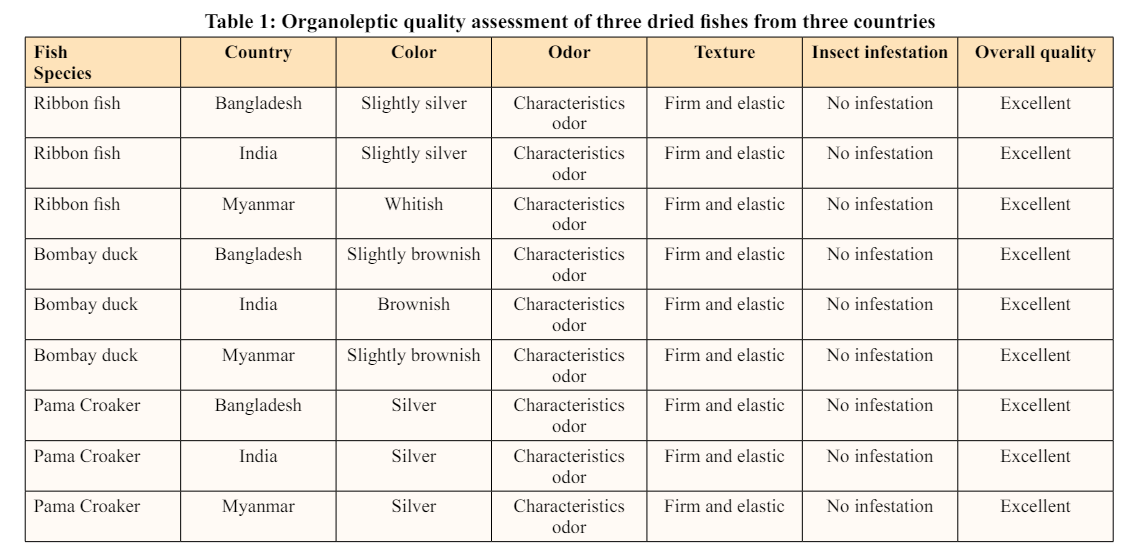
The recorded protein percentages were 51.17± .95% in Bangladesh, 57.60±2.69% in India, and 62.81±2.83% in Myanmar, while lipid percentages across the three countries were 6.46±0.37%, 5.18±0.16% and 11.03±.39%. Ash content was highest in Indian Bombay duck (10.18%), followed by 10.05% in Bangladeshi fish and 9.22% in Myanmar fish. Moisture and fiber content of dried Bombay duck fish from the three countries were recorded at 28.01±0.59%, 19.44±1.02%, 26.58±.45% and .24±.090%, .10±0.11%, .05±0.05% respectively.

On the contrary, Table 3 delineates the fluctuations in the average percentages of moisture, protein, lipids, and ash in dried Trichiurus haumela. In Bangladesh, the average protein percentage was 62.46±1.47%, in India it was 55.50±2.08%, and in Myanmar, it stood at 52.37±2.50%. The average lipid percentage varied among the three nations, with values of 5.36±0.28%, 5.78±0.54%, and 8.70±0.34% respectively. Myanmar Ribbon fish exhibited the highest ash concentration at 9.92±0.27%, followed by Bangladeshi fish at 9.59±0.44%, and Indian fish at 8.91±0.29%. For dried Ribbon fish from the three countries, corresponding moisture and fiber contents were recorded as 18.61±0.59%, 15.51±1.02%, and 20.54±0.45%, and 0.22±0.12%, 0.09±0.06%, 0.09±0.06% respectively.

The average protein percentage was 51.01±.39% in Bangladesh, 50.93±.83% in India, and 51.15±.67% in Myanmar, whereas the average lipid percentage varied among the three nations at 9.13±.94%, 5.44±.09% and 10.86±.48%. Myanmar Pama Croaker exhibited the highest ash concentration at 9.80±0.67%, followed by Bangladeshi fish at 9.177±0.72%, and Indian fish at 9.65±0.16%. For dried Pama Croaker from Bangladesh, India, and Myanmar, the corresponding moisture and fiber contents were 30.67±.55%, 41.64±.53% and 19.95±.246%, and 0.44±.05%, 0.16±.16% and .17±.16%, respectively.

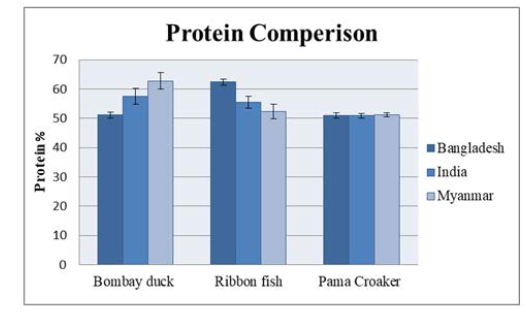
Figure 1: Protein comparison between Bombay duck, Ribbon fish, and Pama croaker from three different countries
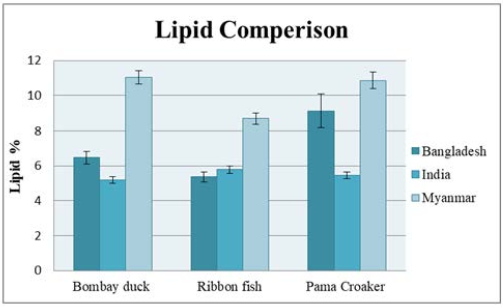
Figure 2: Lipid comparison between Bombay duck, Ribbon fish, and Pama croaker from three different countries
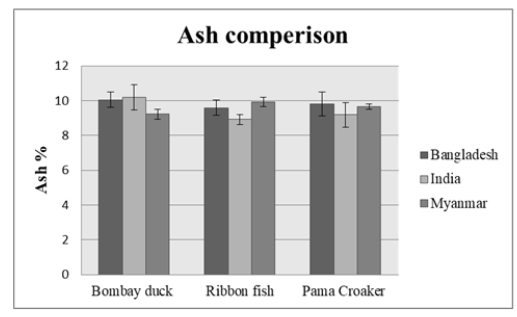
Figure 3: Ash comparison between Bombay duck, Ribbon fish, and Pama croaker from three different countries
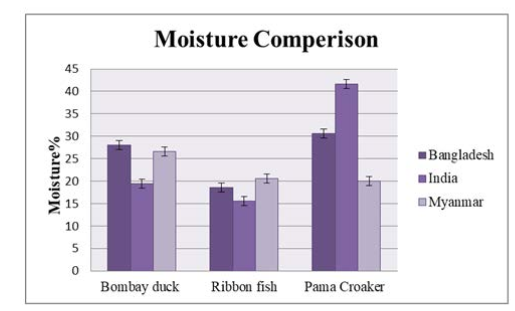
Figure 4: Moisture comparison between Bombay duck, Ribbon fish, and Pama croaker from three different countries
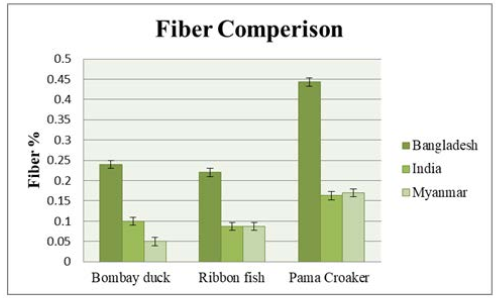
Figure 5: Fiber comparison between Bombay duck, Ribbon fish, and Pama croaker from three different countries
The fatty acid makeup of the analyzed Bombay duck is detailed in Tables 5. The primary fatty acids identified include Methyl Palmitate, Methyl Palmitpleate, Methyl Laurate, Methyl Arachidonate, and Methyl Stearate. The predominant fatty acid observed in Bombay duck is Methyl Linoleate (a saturated fatty acid), consistently found in all three countries, with the highest concentration recorded in Bangladesh. Predominant fatty acids include Methyl Palmitate, Methyl Palmitpleate, Methyl Laurate, Methyl Arachidonate, Methyl Docosahexanoate, and Methyl Stearate. The prevailing fatty acid in Pama Croaker is Methyl Linoleate (a saturated fatty acid), notably found in India and Myanmar, while Methyl Palmitpleate has the highest concentration in Bangladesh.
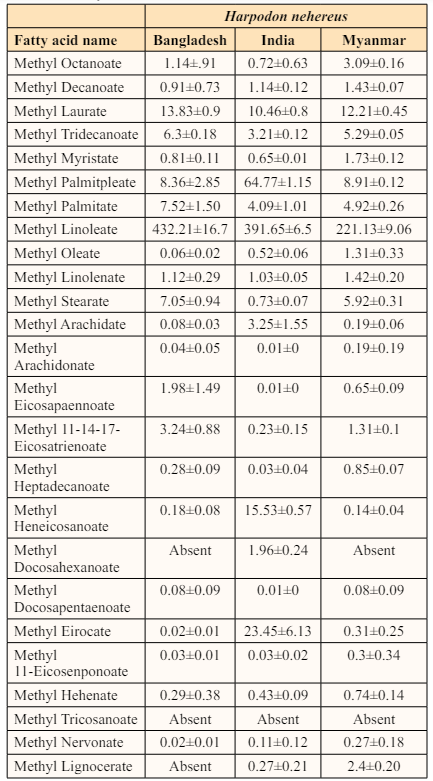
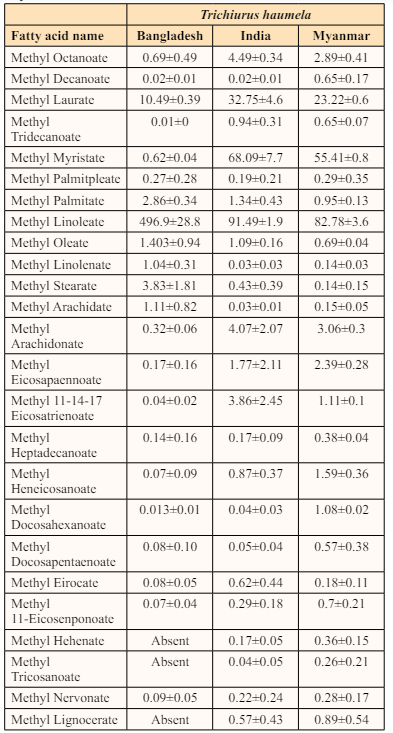
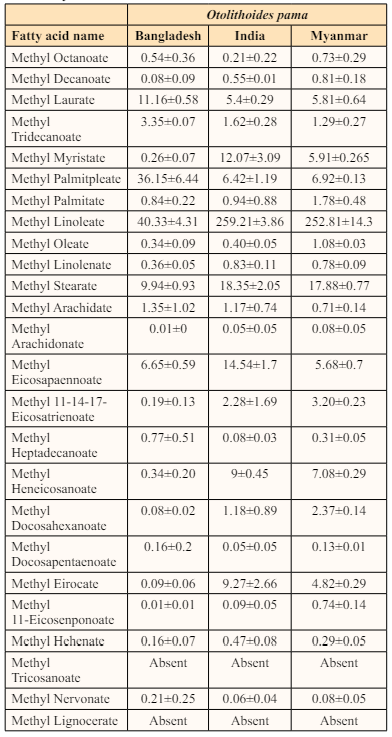
Harpodon nehereus Protein percentages were 51.17±0.948 in Bangladesh, 57.60±2.688 in India, and 62.81±2.828% in Myanmar. Lipid percentages were 6.46±0.372, 5.18±0.163, and 11.03±0.396 across the three countries. Siddique et al. observed changes in protein and lipid levels during storage in three marine dried fishes [10]. Bhuiyan reported protein (55.8-75.9%) and lipid (9.21-6.84%) content in dried fish samples of Harpodon nehereus and Johnius dussumieri [11]. The study finds that the protein and lipid levels in the studied dried fishes align with earlier reports, with Myanmar dried fish showing higher lipid content. Ash content was highest in Indian Bombay duck (10.18%), followed by 10.05% in Bangladeshi fish and 9.22% in Myanmar fish, resembling findings by Gheyasuddin et al. [12]. Moisture and fiber content varied among the three countries, with Siddique et al. noting changes in moisture content in marine dry fishes, and Bhuiyan reporting different moisture levels in dried marine fishes compared to the current study [10,11].
According to Pravakar et al., a proximate analysis revealed that the mean moisture contents of Chinese pomfret (Stromateus chinensis), Bombay duck (Harpodon nehereus), and Ribbon fishes (Trichiurus haumela) were 19.65±0.60%, 27.19±0.27%, and 23.94±0.2% respectively; protein content was 60.03±0.94%, 41.28±0.35%, and 54.36±0.85%; lipid content was 11.92±0.33%, 10.48±0.22%, and 11.45±0.16%; and ash content was 7.21±0.18%, 20.06±0.36%, and 11.05±0.69% [5]. These findings are more or less similar to our present study. According to data from Pravakar et al. the mean moisture content of Ribbon fishes (Trichiurus haumela) was 23.94±0.2%, protein content was 54.36±0.85%, lipid content was 11.45±0.16%, and ash content was 11.05±0.69%, which also aligns with the present study [5].
A study was conducted by Islam et al showed that proximate composition of Pama Croaker that was collected from Cox’s Bazar recorded as 0.93% lipid, 20% ash and 33% moisture [13]. The previous study showed dissimilarities from present study.
Mnari et al. noted variations in the overall lipid content and fatty acid ratios in the dorsal muscle, ventral muscle, and liver when comparing wild and farmed gilthead sea bream [4]. The nutrient levels in fish are significantly influenced by factors such as the species, season, geographic location, diet, age, and reproductive condition of the fish, as emphasized by Lunn and Theobald [14].
Fish plays a crucial role in obtaining n-3 PUFA (specifically EPA and DHA). While the ability to synthesize n-3 fatty acids varies among species and individuals, fish is a notable source of these essential fatty acids. The nutritional profile and fatty acid composition of fish can differ due to various factors. For instance, fatty fish like herring and mackerel contain around 400mg of PUFA in every 15g portion. Therefore, it is recommended that a weekly consumption of 300 g of fatty fish or a daily intake of 200mg of EPA and DHA is adequate [15].
Methyl Docosahexanoate is present in Indian Bombay duck samples but absent in those from Bangladesh and Myanmar, as per Ramesh et al.’s study emphasizing the significance of this pelagic marine resource in India [16]. Ramesh et al. highlight that fresh Bombay Duck from India is rich in n-3 polyunsaturated fatty acids (PUFA), including beneficial compounds like EPA and DHA, which aligns with our findings [16]. Furthermore, reports from Tashiro et al. and Hatano indicate that lipid concentration and fatty acid composition can vary based on factors such as species, diet, geographic origin, and season [17, 18].
The majority of species examined contained the following fatty acids: myristic acid (C14:0, ranging from 0.72% to 8.09%), pentadecanoic acid (C15:0, ranging from 0.05% to 2.35%), palmitic acid (C16:0, varying between 15.97% and 31.04%), palmitoleic acid (C16:1, found at levels between 1.48% and 19.61%), heptadecanoic acid (C17:0, with concentrations of 0.01% to 1.84%), cis-10-heptadecenoic acid (C17:1, ranging from 0.17% to 2.01%), stearic acid (C18:0, present at levels from 2.79% to 11.20%), oleic acid (C18:1n-9, varying from 2.44% to 28.97%), linoleic acid (C18:2n-6, ranging from 0.06% to 3.48%), arachidonic acid (C20:4n-6, found at concentrations between 0.12% and 10.72%), cis-5,8,11,14,17-EPA (C20:5n-3, present at levels from 1.94% to 10%), and cis-4,7,10,13,16,19-DHA (C22:6n-3, with amounts ranging from 3.31% to 31.03%). These results are in agreement with previous studies on fatty acids of other species [19].
Ramesh et al. noted in their study that palmitic acid (15.02- 29.26%) and stearic acid (9.24-19.94%) were the most prevalent saturated fatty acids (SFA) in the muscle tissue of ribbon fish, aligning closely with our current findings [20].
Essential fatty acids for human health, such as Linoleic acid (C18:2n6) and α-linolenic acid (C18:3n3), were present in cultured fresh yellow croaker muscle at 0.033% and 0.04%, respectively, as per Chen et al. [21]. This aligns with our current dried fish study, indicating that Pama Croaker is a rich source of fatty acids. Renuka et al. reached a similar conclusion regarding the tiger tooths croaker [22, 23].
This study furnishes information on the nutritional composition of three commercially significant dried fish species (Otolithoides pama, Trichiurus haumela, Harpodon nehereus) sourced from three distinct countries: Bangladesh, India, and Myanmar. The quality of the fish from all three countries was deemed excellent. Each of the three fish varieties from every country exhibited substantial levels of protein, ash, and moisture. The investigation also highlighted elevated levels of n-3 (omega-3) polyunsaturated fatty acids (PUFA) in these fish, which are recognized for their potential to mitigate the risk of coronary heart diseases. Notably, Methyl Linoleate was present in significant quantities in all three samples. The results indicate that these studied fish resources boast a notable protein content, suggesting their potential economic utility in addressing protein requirements. Future studies in this domain may benefit from focusing on the analysis of vitamins, minerals, and microbial content, moving beyond proximate analysis.
